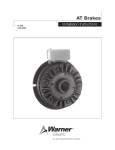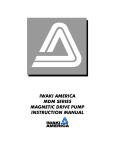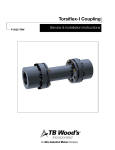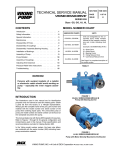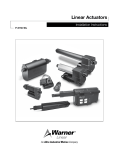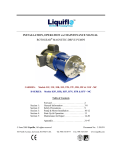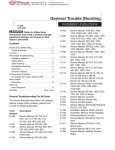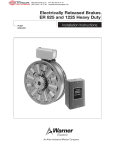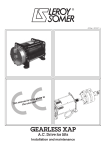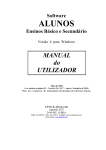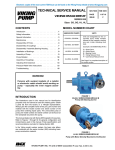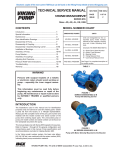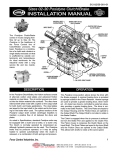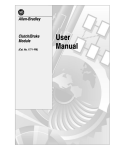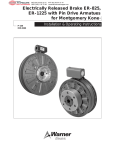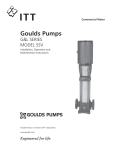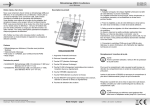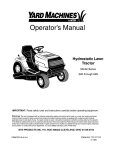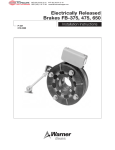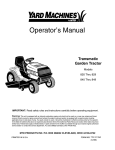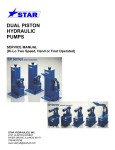Download Electro-Module EM-50, EM-100, EM-180, EM-210, EM-215
Transcript
Electro-Module EM-50, EM-100, EM-180, EM-210, EM-215 Service & Installation Instructions P-213-WE 819-0303 An Altra Industrial Motion Company Contents Pre-Installation Instructions Pre-Installation Instructions . . . . . . . . . . . . . . . .2 Installation Instructions . . . . . . . . . . . . . . . . . . .4 Setting Airgap . . . . . . . . . . . . . . . . . . . . . . . . . .5 Electrical Coil Data . . . . . . . . . . . . . . . . . . . . . .8 Burnishing . . . . . . . . . . . . . . . . . . . . . . . . . . . . .9 Troubleshooting . . . . . . . . . . . . . . . . . . . . . . . . .9 Maintenance . . . . . . . . . . . . . . . . . . . . . . . . . . .9 Overhung Load Data . . . . . . . . . . . . . . . . . . . .11 Dimensions and Specifications EM-50-10 . . . . . . . . . . . . . . . . . . . . . . . . . .12 EM-100-10 . . . . . . . . . . . . . . . . . . . . . . . . .12 EM-180-10 . . . . . . . . . . . . . . . . . . . . . . . . .12 EM-210-10 . . . . . . . . . . . . . . . . . . . . . . . . .12 EM-50-20 . . . . . . . . . . . . . . . . . . . . . . . . . .13 EM-100-20 . . . . . . . . . . . . . . . . . . . . . . . . .13 EM-180-20 . . . . . . . . . . . . . . . . . . . . . . . . .13 EM-210-20 . . . . . . . . . . . . . . . . . . . . . . . . .13 EM-215-20 . . . . . . . . . . . . . . . . . . . . . . . . .13 EM-50-30 . . . . . . . . . . . . . . . . . . . . . . . . . .14 EM-100-30 . . . . . . . . . . . . . . . . . . . . . . . . .14 EM-180-30 . . . . . . . . . . . . . . . . . . . . . . . . .14 EM-210-30 . . . . . . . . . . . . . . . . . . . . . . . . .14 EM-50-40 . . . . . . . . . . . . . . . . . . . . . . . . . .15 EM-100-40 . . . . . . . . . . . . . . . . . . . . . . . . .15 EM-180-40 . . . . . . . . . . . . . . . . . . . . . . . . .15 EM-210-40 . . . . . . . . . . . . . . . . . . . . . . . . .15 EM-10-20 . . . . . . . . . . . . . . . . . . . . . . . . . .16 EM-10-40 . . . . . . . . . . . . . . . . . . . . . . . . . .17 EM-20-30 . . . . . . . . . . . . . . . . . . . . . . . . . .18 EM-30-40 . . . . . . . . . . . . . . . . . . . . . . . . .19 NEMA Frame Standards . . . . . . . . . . . . . .20 Warranty . . . . . . . . . . . . . . . . . . . .Back Page A. Before installing the Electro-Module to a motor or reducer, make certain that the EM size and NEMA frame dimensions match according to Table 1. EM Size 50 100 180 210 215 Corresponding NEMA Frame Sizes 48Y/56C 48Y/56C 143TC/145TC 182TC/213TC 213TC/215TC Shaft Dia. 5/8 5/8 7/8 1-1/8 1-3/8 C-Face Pilot Dia. 4-1/2 4-1/2 4-1/2 8-1/2 8 1/2 Table 1 B. Check the motor for shaft endplay. If the shaft can be moved axially .030” or more, the module should not be installed since excessive thrust may occur between the rotor and field. The motor should not be used unless the endplay can be reduced. C. Install your specific modular combination according to the installation steps specified in Table 2. Use only those steps indicated for each combination. Failure to follow these instructions may result in product damage, equipment damage, serious or fatal injury to personnel. 2 Warner Electric • 800-825-9050 P-213 • 819-0303 For these EM combinations: Use sections: Electro Module Clutch-Brake Between C-Face Motor and Reducer – 10-20 A, B, C, G, H, I Electro Module Clutch Between Motor and Reducer – 10-40 A, B, C, G, H, I Electro Module Clutch Brake – 20-30 B, C, G, H, I Electro Module Clutch – 30-40 B, C, G, H, I Electro Module Brake on C-Face Motor – 20 D, C, G, H, I Motor Mount Electro Module Clutch-Brake on C-Face Motor – 20-M C, E, H, I Motor Mount Electro Module ClutchBrake on C-Face Motor – 10-20-M A, B, C, E, H, I Motor Mount Electro Module Clutch on C-Face Motor – 10-40-M A, B, C, E, H, I Base-Mounted Electro Module Clutch-Brake – 20-30-B B, C, F, H, I Base-Mounted Electro Module Clutch – 30-40-B B, C, F, H, I Table 2 Warner Electric • 800-825-9050 P-213 • 819-0303 3 Installation Instructions Section A: Mounting the Motor Clutch Module (10 Module) 1. Examine the clutch adapter. Note that there are gaps between the housing fins on roughly half of the circumference of the unit. Mount the clutch adapter with the open gaps down. This will keep contaminants from falling into the unit. There are four screws and washers. These will be bolted through the adapter onto the four holes in the face of the motor (See Figure 1). 3. Slide the rotor onto the motor shaft. (See Figure 3) Make sure the rotor hub slides easily onto the shaft. If the fit is too tight, polish the shaft with emery paper so the hub will slide on easily. Do not use a hammer or force the rotor hub onto the shaft. Slide the rotor back off the shaft. Figure 3 Figure 1 2. Look at the back side of the rotor and note there are cardboard spacer buttons as depicted in figure 2. 4. Insert key onto the shaft. Prick punch the motor shaft keyway at the end of the key to prevent the key from sliding out. Slide the rotor onto the motor shaft until it bottoms against the field. 5. Using an Allen Wrench securely tighten the two setscrews in the rotor hub. (See Figure 4) When the motor is turned on, the spacer buttons will quickly wear away and provide the proper gap between the field and rotor. The setscrews are accessible from the front of the rotor on sizes 100, 180, 210, and from behind the rotor on size 50 units. Figure 2 Figure 4 4 Warner Electric • 800-825-9050 P-213 • 819-0303 Section B: Bolting Two Modules Together The brake module (20) and/or output clutch module (40) may be assembled to the mounted motor clutch module (10) or the input clutch (30). 1. Position the modules so that, in the usual horizontal position, the ventilation holes are down to prevent foreign matter from falling into the units. 2. Bolt the modules together with the long hex head bolts that are provided, see figure 5. Mating pilot diameters assure proper alignment between module assemblies. Figure 6 3. Proceed to Section C Figure 7 Figure 5 If the armature for either the clutch or the brake is too far away from its mating friction surface, it is possible to move this back into adjustment using a flat blade screwdriver between the two armatures. See figure 8. Section C: Adjusting Airgap For new installations it is necessary to adjust the airgap between the friction faces of the clutch and/or brake. To set the airgap for an Electro-Module (EM) you will need to access the armatures. On an EM there are gaps between the fins on the housing on 1/2 of the unit circumference. When looking through this gap, you will see the fan on the clutch rotor. In that fan there is a 1/2 x 1 inch window. It is possible to look inside the unit and see the armatures by looking through this window. When looking through this window you will be looking between the two armatures of a clutch/brake unit as shown in figures 6 and 7. Warner Electric • 800-825-9050 Figure 8 P-213 • 819-0303 5 This is a three step process. 1. Simply slide the screwdriver through the window and press the armature toward its mating friction surface. 2. Rotate the output of the unit. The rotor and the window should stay in place when you do this. Only the armatures will move. Rotating the rotor will move the window. 3. Repeat steps 1 & 2 to ensure that the airgap between armature and its mating friction surface is about 1/32” and that the armature is kept square. (If the armature is cocked, it may engage on one rim, giving the appearance of engagement but failing to provide full torque.) Section D: Mounting the Brake to a Motor The brake module (20) can be mounted directly to a motor. 1. Insert a key in the motor shaft keyway. Prick punch the end of the (EM-50 and EM-100) motor shaft keyway to prevent the key from sliding out. 2. A set collar is provided in the EM-180 and EM-210 mounting accessory to prevent the key from sliding out. Slide the set collar up against the motor bearing and tighten the setscrew securely. (Figure 9) 3. When using the EM-180-20 a possible interference may exist between the splined armature hub and some motors. (See Figure 10) A spacer ring is provided with the EM-180 mounting accessory to provide the necessary running clearance. C-face mounting If this boss extends beyond the C-face surface use the spacer. Do not use spacer if boss is below the C-face surface. Figure 10 Place the spacer ring between the brake module housing and the C-face of the motor when bolting the two units together. 4. Align the motor shaft and key with the mating shaft hole and key slot in the brake module. 5. Secure brake module to the motor C-face with the four (4) long 3/8-inch hex head capscrews. Section E: Installing the Motor Mount (M) A Motor Mount (M) can be installed to the brake or output clutch module to provide a foot mounting for the complete assembly of module and motor. 1. Remove the two (2) long hex head bolts from the side of the module toward the ventilation holes. 2. Mount the module on the Motor Mount so that the base of the Motor Mount is underneath the modules and motor. (See Figure 11) A pilot diameter on the module mates with a pilot diameter on the Motor Mount. Figure 9 6 Warner Electric • 800-825-9050 P-213 • 819-0303 Section G: Mounting to a Reducer The output side of a brake (20) or output clutch (40) module may be mounted directly to a reducer. 1. Align the output shaft and key of the modules with the corresponding shaft hole and keyway of the reducer. Slide the assembly together, matching the pilot diameter on the module with a pilot diameter on the reducer. (Figure 13) Figure 11 3. Secure the Motor Mount in place with two (2) longer mounting bolts and the two shorter bolts all provided in the kit. Section F: Installing the Base Mount Modules 20-30 and 30-40 can be base-mounted. Figure 13 1. Mount the modules so that the base is located below the ventilation holes. A pilot diameter on the end of each module mates with pilot diameters on the base. 2. Bolt the module to the reducer flange. The four (4) bolts required (3/8 - 16 UNC-2A) are normally furnished with the reducer. 2. Secure the base to the modules with the four (4) bolts provided. (Figure 12) Section H: Electrical Connections The conduit connection hole in the motor clutch module (10), brake (20), and input clutch (30) are threaded for standard conduit connectors. The wiring diagram, included with each Warner Electric control shows the proper electrical connections that must be made. (Control Service Manual P-239 includes complete information on all standard control power supplies.) Figure 12 For clutch/brake combinations, connect the red wire from one module and the black wire from the other module to the same terminal of the DC supply. With most basic Warner Electric controls, one terminal is normally used for two connections – one from the brake and one from the clutch. For wiring of clutches, brakes, and clutch/brake combinations consult manual P-239 for the wiring diagram of the control being used. These clutch/brakes are not polarity sensitive. Warner Electric • 800-825-9050 P-213 • 819-0303 7 Electrical Coil Data EM - 50 - 100 - 180 - 210 - 215 Voltage – D.C. 90 24 Clutch Brake Clutch Brake Clutch Brake Resistance EM-50 452 452 1.86 1.86 31.8 31.8 @ 20˚ C - 0hms EM-100 392 392 1.8 1.8 26.7 26.7 EM-180 392 392 1.8 1.8 26.7 26.7 EM-210 248 248 1.22 1.22 17.9 17.9 EM-215 Amperes 248 EM-50 .199 .199 3.23 3.23 .755 .755 EM-100 .23 .23 3.31 3.31 .896 .896 EM-180 .23 .23 3.31 3.31 .896 .896 EM-210 .363 .363 4.9 4.9 1.34 1.34 EM-215 Watts .363 EM-50 18 18 19 19 18 18 EM-100 21 21 20 20 21.5 21.5 EM-180 21 21 20 20 21.5 21.5 EM-210 33 33 30 30 32 32 EM-215 Build-up – milliseconds 33 EM-50 52 53 52 53 52 53 EM-100 72 75 72 70 72 75 EM-180 72 75 72 70 72 75 EM-210 120 100 110 100 120 100 EM-215 Decay – milliseconds Warner Electric • 800-825-9050 100 EM-50 6.2 5.0 6.5 5.0 6.2 5.0 EM-100 12 10 12 10 12 10 EM-180 12 10 12 10 12 10 EM-210 20 10 20 10 20 10 EM-215 8 6 10 P-213 • 819-0303 Section I: Burnishing Intimate metal to metal contact is essential between the armature and the metal rings (poles) of the magnet or rotor. Warner Electric clutches and brakes leave the factory with the friction material slightly undercut to assure good initial contact. Normally, the desired wearing-in process occurs naturally as the surfaces slip upon engagement. The time for wear-in, which is necessary to obtain the ultimate torque of the unit, will vary depending on speed, load, and duty cycle. If maximum torque is required immediately after installation, the unit should be burnished by slipping the friction surfaces together at reduced voltage. It is recommended that the burnishing be done right on the application, if at all possible. A. Visually inspect to ensure that the lead wires are not split or cut. B. Using a voltmeter confirms that DC voltage is reaching the lead wires when it should be and that the coil resistance is correct. Mechanical - A likely mechanical cause for a clutch or brake not engaging when DC power is applied is that the airgap between the friction faces is too large. When power is applied to an Electro-magnetic clutch/brake, the unit magnetically clamps the friction faces together. An airgap that is too large can keep the unit from clamping together. If the airgap is too small the faces will rub all of the time. To adjust the airgap, see Section C on page 5. Maintenance Burnishing at high speed will result in a smoother wear-in pattern and reduce the time for burnishing. The voltage should be set at approximately 30% or 40% of the rated value. The unit should be cycled on and off to allow sufficient time between slip cycles to prevent overheating. When a Warner Electric brake or clutch is properly assembled and installed, no further servicing, lubrication, or maintenance should be required throughout the life of the unit. Troubleshooting As with any friction-type device, some initial concern should be given to wear rate, as minor adjustments in actuation time can sometimes extend the life of the unit. For clutch modules, the control potentiometer should be set high to reduce the actuation time. For brakes, the setting can be reduced to extend the braking time and thereby extend the life. Once the best actuation time has been established, precautions should be taken to prevent machine operators, or other personnel not familiar with wear characteristics, from changing the potentiometer setting arbitrarily for affecting minor operating changes. If an Electro-Module fails to engage, there are several possible causes. These can be broken down into two sub-headings: Electrical and Mechanical. Electrical - If a clutch or brake or clutch/brake will not engage, review the wiring, switching and connections. Warner Electric • 800-825-9050 P-213 • 819-0303 9 Wear Pattern Torque Loss Wear grooves appear on the friction surfaces. This is a normal wear condition, and does not impair functioning of the unit. Never machine the friction surfaces to remove grooves or score marks resulting from normal wear. If a brake or clutch module slips or loses torque completely, the initial check should be the input voltage to the magnet or field as follows: Heat Excessive heat and high operating temperatures are causes of rapid wear. Units, therefore, should be ventilated as efficiently as possible, especially if the application requires fast, repetitive cycle operation. Foreign Materials If units are used on machinery where fine, abrasive dust, chips or grit are dispelled into the atmosphere, a screen over the ventilation holes may be necessary. Where units are used near gear boxes or transmissions requiring frequent lubrication, means should be provided to protect the friction surfaces from oil and grease to prevent serious loss of torque. Oil and grease accidentally reaching the friction surfaces may be removed by wiping with a rag dampened with a suitable cleaner, which leaves no residue. In performing this operation, do not drench the friction material. If the friction materials have been saturated with oil or grease, no amount of cleaning will be completely effective. Once such a unit has been placed back in service, heat will cause the oil to boil to the surface, resulting in further torque loss. 10 Warner Electric • 800-825-9050 90-Volt Series: Connect a DC voltmeter with a range of 0-100 or more directly across the magnet or field terminals. With the power on and the potentiometer turned up, a normal reading is 90 volts, although 85 to 95 is satisfactory. The reading should drop as the potentiometer control is adjusted counter-clockwise. 24 Volt Series: Use a DC voltmeter of approximately 0-40 volt range. A normal reading is from 23 to 25 volts. 6-Volt Series: Use a DC voltmeter of approximately 0-15 volt range. A normal reading is from 5.5 to 6.5 volts depending on the power supply. The above checks normally are sufficient. Further checks may be made as follows: a low range ammeter, when connected in series with one magnet lead, will indicate amperes as shown in chart on page 8. These readings are with the power on and the potentiometer control in the maximum position. Ohmmeter checks should be made with the power off and the circuit open (to be certain, disconnect one lead to the magnet). A very high or infinite resistance reading would indicate an open coil. If the above checks indicate that the proper voltage and current is being supplied to the coil mechanical parts should be checked to assure that they are in good operating condition and properly installed. P-213 • 819-0303 Overhung Load Data (Shaft Side Load) Overhung load data is provided in this manual for the design engineer concerned with a specific problem in this area. The maximum allowable overhung load which can be applied to the shaft of an ElectroModule may be determined by the use of the accompanying chart. A R The minimum pitch diameter pulley or sprocket that can be used, for satisfactory bearing life, is determined from the formula: 2TK Min. P. D. = –––––– R T - Torque, (lbs. in.). This is the torque actually being transmitted, not necessarily the maximum torque capacity of the Electro-Module. ElectroModule Distance Load Applied from Housing Face “A” Inches EM-50 1" - Center of Shaft 2" - End of Shaft 3" EM-100 1" - Center of Shaft 2" - End of Shaft 3" EM-180 1" - Center of Shaft 2" - End of Shaft 3" EM-210 1-3/8" - Center of Shaft 2-3/4" - End of Shaft 4-1/8" EM-215 1-3/8" - Center of Shaft 2-3/4" - End of Shaft 4-1/8" Based on B10 Life at 3600 RPM Maximum Load Rating “R” Lbs. 177 123 95 192 134 104 192 134 104 386 271 208 386 271 208 Example: What is the minimum V-belt pulley that can be applied to the center of the shaft of an EM-50 module? The torque requirement is 112 in. lbs. 2 x 112 x 2 Min. P. D. = –––––––––– = 2" minimum P. D. 224 pulley 63025 x HP Torque = ––––––––––– RPM K - the safety factor for the tension in the type of drive. Use: 1 for chain and sprocket 1 for timing belt 2 for V-belt 3 for flat belt R - Radial load allowable (values at various distances from the housing face are given in the chart). Warner Electric • 800-825-9050 P-213 • 819-0303 11 10 Motor Clutch Module 50-10 100-10 180-10 E F 210-10 AA 1/2" NPT BB DD D B A 1/2" NPT CC Electrical Connection C Typical End View All dimensions are nominal, unless otherwise noted. Size A Pilot Dia. B Dia. C D Dia. E Max. F Max. AA BB Min. CC DD Key 50 4.500 .625 .813 6.750 .599 1.563 30° 36 45° 3/16 x 3/16 100 4.500 .625 .813 6.750 .599 1.563 30° 36 45° 3/16 x 3/16 180 4.500 .875 .813 6.750 .599 1.563 30° 36 45° 3/16 x 3/16 210 8.500 1.125 .703 9.250 .625 1.313 25° 36 45° 1/4 x 1/4 Specifications Model Size Voltage DC Static Torque (lb. ft.) Max. RPM Inertia–WR2 (lb.ft.2) Weight (lbs) NEMA Frame Size 50 100 180 6, 24, 90 6, 24, 90 6, 24, 90 16 30 30 3600 3600 3600 .020 .046 .046 3.4 5.1 5.1 210 6, 24, 90 95 3600 .188 9.1 56C/48Y* 56C/48Y** 182C/143TC 184C/145TC 213C/182TC 215C/184TC * For 56C/48Y Frame motors 3/4 HP and smaller the EM-100 size may be used where extended life is desirable. ** EM-100 size is recommended for motors 1 HP and larger. 12 Warner Electric • 800-825-9050 For NEMA Standard frame sizes, see page 20. P-213 • 819-0303 AA A B Electrical Connection C D 20 Brake Module 50-20 100-20 180-20 210-20 215-20 E 1/2" NPT BB F DD J I H L See Note A G K See Note B Notes: A. Same overall dimensions apply to Motor Brakes. 20MB Module does not have an output shaft. B. Clutch armature only applies to EM-20. CC Typical End View All dimensions are nominal, unless otherwise noted. Size 50 A Max. 5.188 B 3.125 C D E Max. Max. .500 1.000 .156 100 5.188 3.125 .500 1.000 .156 180 5.266 3.125 .500 1.000 .156 210 7.578 4.609 .594 1.500 .313 215 8.078 4.609 .594 1.500 .313 F 3/8-16 UNC-2A Equally Spaced (4) on 5.875 D. 3/8-16 UNC-2A Equally Spaced (4) on 5.875 D. 3/8-16 UNC-2A Equally Spaced (4) on 5.875 D. 1/2-16 UNC-2A Equally Spaced (4) on 7.250 D. 1/2-16 UNC-2A Equally Spaced (4) on 7.250 D. G Dia. 6.688 6.688 6.688 9.344 9.344 H I J K L Dia. Keyway Min. Pilot Dia. Dia. .625 3/16 X 1.813 4.500 .625 3/16 x 1-3/8 .625 3/16 X 1.813 4.500 .625 3/16 x 1-3/8 .875 3/16 X 1.891 4.500 .875 3/16 x 1-3/8 1.125 1/4 X 2.500 8.500 1.125 1/4 x 2 1.375 1/4 X 3.000 8.500 1.375 1/4 x 2 AA 30° BB Min. 36 DD CC Key 45° 3/16 x 3/16 30° 36 45° 3/16 x 3/16 30° 36 45° 3/16 x 3/16 25° 36 45° 25° 36 45° 5/16 x 5/16 1/4 x 1/4 Specifications Model Size Voltage DC 50 6, 24, 90 100 6, 24, 90 180 6, 24, 90 Static Torque (lb. ft.) 16 30 30 Max. RPM 3600 3600 3600 Armatures .014 .036 .036 Inertia–WR2 (lb.ft.2) Arm. Hub Shaft .002 .001 .003 .002 .003 .002 Weight (lbs) 6.6 8.1 8.1 210 6, 24, 90 95 3600 .162 .021 .017 21.5 215 90 95 3600 .162 .021 .019 22 * For 56C/48Y Frame motors 3/4 HP and smaller the EM-100 size may be used where extended life is desirable. ** EM-100 size is recommended for motors 1 HP and larger. *** For 7-1/2 HP max. Warner Electric • 800-825-9050 NEMA Frame Size 56C/48Y* 56C/48Y** 182C/143TC 184C/145TC 213C/182TC 215C/184TC 213TC/215TC*** For NEMA standard frame sizes, see page 20. P-213 • 819-0303 13 30 Input Clutch Module 50-30 100-30 180-30 210-30 G B A H AA 1/2" NPT Electrical Connection BB DD D I F E C CC Typical End View All dimensions are nominal, unless otherwise noted. Size A 50 1.000 B Max. 1.56 100 1.000 1.56 180 1.000 1.56 210 1.500 .312 C 3/16 x 3/16 x 1-3/8 3/16 x 3/16 x 1-3/8 3/16 x 3/16 x 1-3/8 1/4 x 1/4 D Min. 1.813 E Pilot Dia. 4.500 F Dia. .625 G Max. 4.328 H 2.266 I Dia. 6.688 1.813 4.500 .625 4.328 2.266 1.891 4.500 .875 4.391 2.500 8.500 1.125 5.391 AA 30° BB Min. 36 CC 45° DD` Key 3/16 x 3/16 6.688 30° 36 45° 3/16 x 3/16 2.266 6.688 30° 36 45° 3/16 x 3/16 2.438 9.219 25° 36 45° 1/4 x 1/4 Specifications Model Size 50 100 180 210 Voltage DC 6, 24, 90 6, 24, 90 6, 24, 90 Static Torque (lb. ft.) 16 30 30 Max. RPM 3600 3600 3600 6, 24, 90 95 3600 * For 56C/48Y Frame motors 3/4 HP and smaller the EM-100 size may be used where extended life is desirable. ** EM-100 size is recommended for motors 1 HP and larger. 14 Warner Electric • 800-825-9050 Inertia–WR2 (lb. ft.) Rotor Shaft .020 .001 .046 .002 .046 .002 .188 .017 Weight (lbs) 6.4 8.4 8.4 19.8 NEMA Frame Size 56C/48Y* 56C/48Y** 182C/143TC 184C/145TC 213C/182TC 215C/184TC For NEMA standard frame sizes, see page 20. P-213 • 819-0303 40 Output Clutch Module 50-40 100-40 AA 180-40 210-40 1/2" NPT A B C BB DD F D H E G CC Typical End View All dimensions are nominal, unless otherwise noted. Size 50 A Max. 5.188 100 B 3.125 C Max. .156 D Dia. 6.687 5.188 3.125 .156 6.687 180 5.266 3.125 .313 6.687 210 7.578 4.609 .313 9.344 E 3/16 x 3/16 x 1-3/8 3/16 x 3/16 x 1-3/8 3/16 x 3/16 x 1-3/8 1/4 x 1/4 x 2 F Min. 1.813 G Pilot Dia. 4.500 H Dia. .625 1.813 4.500 1.891 2.500 AA 30° BB Min. 36 CC 45° DD Key 3/16 x 3/16 .625 30° 36 45° 3/16 x 3/16 4.500 .875 30° 36 45° 3/16 x 3/16 8.500 1.125 25° 36 45° 1/4 x 1/4 Specifications Model Size Voltage DC 50 6, 24, 90 100 6, 24, 90 180 6, 24, 90 210 Static Torque lb. ft. 16 30 30 Max. RPM 3600 3600 3600 Armatures .007 .018 .018 95 3600 .181 6, 24, 90 * For 56C/48Y Frame motors 3/4 HP and smaller the EM-100 size may be used where extended life is desirable. ** EM-100 size is recommended for motors 1 HP and larger. Warner Electric • 800-825-9050 Inertia–WR2 (lb. ft.) Arm. Hub Shaft .002 .001 .003 .002 .003 .002 .021 .017 Weight (lbs) 4.9 5.2 5.2 15.2 NEMA Frame Size 56C/48Y* 56C/48Y** 182C/143TC 184C/145TC 213C/182TC 215C/184TC For NEMA standard frame sizes, see page 20. P-213 • 819-0303 15 EM-10/20 Clutch/Brake Combination I A C D K E J L 10 Motor Clutch Module 20 Brake Module B N O N M Note: Mounting base is optional and is ordered separately. Motor Clutch (10) and Output Clutch (20) are ordered separately. All dimensions are nominal, unless otherwise noted. Size A B C D E I J K L M N O NEMA Frame Size 50 6.750 4.844 1.813 6.750 .625 6.688 3.500 6.844 2.000 6.000 .500 5.000 56C/48Y* 100 6.750 4.844 1.813 6.750 .625 6.688 3.500 6.844 2.000 6.000 .500 5.000 56C/48Y** 180 6.828 4.844 1.891 6.750 .875 6.688 4.500 7.844 3.000 6.625 .813 5.000 182C/143TC 184C/145TC 210 8.891 5.922 2.500 9.250 1.125 9.688 5.250 9.906 3.375 9.000 .625 7.750 213C/182TC 215C/184TC * For 56C/48Y Frame motors 3/4 HP and smaller the EM-100 size may be used where extended life is desirable. ** EM-100 size is recommended for motors 1 HP and larger. 16 Warner Electric • 800-825-9050 For NEMA standard frame sizes, see page 20. P-213 • 819-0303 EM-10/40 Motor Clutch/Output Clutch Combination A I C D E K J L 10 Motor Clutch Module 40 Output Clutch Module B N O N M Note: Mounting base is optional and is ordered separately. Motor Clutch (10) and Output Clutch (40) are ordered separately. All dimensions are nominal, unless otherwise noted. Size A B C D E I J K L M N O NEMA Frame Size 50 6.750 4.844 1.813 6.750 .625 6.688 3.500 6.844 2.000 6.000 .500 5.000 56C/48Y* 100 6.750 4.844 1.813 6.750 .625 6.688 3.500 6.844 2.000 6.000 .500 5.000 56C/48Y** 180 6.828 4.844 1.891 6.750 .875 6.688 4.500 7.844 3.000 6.625 .813 5.000 182C/143TC 184C/145TC 210 8.891 5.922 2.500 9.250 1.125 9.688 5.250 9.906 3.375 9.000 .625 7.750 213C/182TC 215C/184TC * For 56C/48Y Frame motors 3/4 HP and smaller the EM-100 size may be used where extended life is desirable. ** EM-100 size is recommended for motors 1 HP and larger. Warner Electric • 800-825-9050 For NEMA standard frame sizes, see page 20. P-213 • 819-0303 17 EM-20/30 Brake/Input Clutch Combination EM-20/30-B Brake/Input Clutch Combination – Base Mounted B I A C C D D 30 Input Clutch Module K 20 Brake Module H F G E L H F J N O N M Note: Mounting base is optional and is ordered separately. Input Clutch (30) module and Brake Module (20) are ordered separately. All dimensions are nominal, unless otherwise noted. Size A B C Min. D E F G H I J K L M N O 50 5.719 9.516 1.813 .625 5.672 .844 4.000 .344 6.688 3.500 6.844 2.000 6.000 .500 5.000 100 5.719 9.516 1.813 .625 5.672 .844 4.000 .344 6.688 3.500 6.844 2.000 6.000 .500 5.000 180 5.719 9.656 1.891 .875 5.672 .844 4.000 .344 6.688 4.500 7.844 3.000 6.625 .813 5.000 210 7.719 12.969 2.500 1.125 8.203 1.094 6.000 .438 9.688 5.250 9.906 3.375 9.000 .625 7.750 18 Warner Electric • 800-825-9050 P-213 • 819-0303 EM-30/40 Input Clutch/Output Clutch Combination EM-30/40 Input Clutch/Output Clutch Combination – Base Mounted B I A C C D D 30 Input Clutch Module K 40 Output Clutch H F G E L H F J N O N M Note: Mounting base is optional and is ordered separately. Input Clutch (30) module and Output Clutch (40) are ordered separately. All dimensions are nominal, unless otherwise noted. Size A B C Min. D E F G H I J K L M N O 50 5.719 9.516 1.813 .625 5.672 .844 4.000 .344 6.688 3.500 6.844 2.000 6.000 .500 5.000 100 5.719 9.516 1.813 .625 5.672 .844 4.000 .344 6.688 3.500 6.844 2.000 6.000 .500 5.000 180 5.719 9.656 1.891 .875 5.672 .844 4.000 .344 6.688 4.500 7.844 3.000 6.625 .813 5.000 210 7.719 12.969 2.500 1.125 8.203 1.094 6.000 .438 9.688 5.250 9.906 3.375 9.000 .625 7.750 Electro-Modules are individual clutch or brake units which are assembled together to comprise a clutch, a brake or a clutch/brake combination. Electro-Modules are designed for use with Cface motors and reducers. Some versions can be base mounted as well. Prior to assembly ensure that the components you have will create the unit you need. Warner Electric • 800-825-9050 The 10 Motor Clutch Module is designed to mount on the face of the NEMA C-Face motor. The rotor assembly has a hollow bore and is mounted onto the shaft of the motor. The 10 Module cannot be used alone, it must be used with either the 40 Module to create a clutch combination or a 20 Module to create a clutch/brake combination. P-213 • 819-0303 19 The 20 Brake Module is designed to mount on the face of the NEMA C-face motor or in combination with other modules. The 20 can be used alone when mounted on the output of a motor. In this mode it is a brake only. When combined with the 10 Module, it becomes a clutch/brake for mounting on a motor shaft. When combined with a 30 Module it becomes a clutch/brake for base mounting. with the 40 Module to create a clutch combination or it can be used with a 20 Brake Module to create a clutch/brake combination. An optional base is commonly used with these combinations to provide a foot mounting capability. The 40 Output Module is used with either the 10 or the 30 Modules. It cannot be used alone. When combined with a 10 Module or the 30 Module it completes a clutch combination. The 30 Input Clutch Module is designed for applications where the unit is coupled to the motor or where sprocket or pulley is mounted on the input shaft of the 30 Clutch module. The 30 Module cannot be used alone. It can be used Note: This manual addresses only ElectroModules with power engaged components. S NEMA Frame Standards R AH BF AJ ES U AK T BF BB Specifications AH Shaft Length 2.06 AJ Mtg. Bolt Center Dia. 5.875 AK Mtg. Flange Pilot Dia. 4.500 BB Pilot Depth 5/32 100 2.06 5.875 4.500 5/32 180 2.04 5.875 4.500 5/32 210 2.56 7.250 8.500 5/16 215 3.12 7.250 8.500 5/16 Module Size 50 BF Mtg. Bolt Size, Qty. 3/8-16 UNC 4 @ 90° 3/8-16 UNC 4 @ 90° 3/8-16 UNC 4 @ 90° 1/2-13 UNC 4 @ 90° 1/2-13 UNC 4 @ 90° ES Keyway Length 1-1/4 R Depth Over Keyway .517 S Keyway Width 3/16 T Mtg. Bolt Ref. 45° U Shaft Dia. .625 1-1/4 .517 3/16 45° .625 1-1/4 .771 3/16 45° .875 2 .986 1/4 45° 1.125 2 1.201 5/16 45° 1.375 Note: Warner Modules are designed to comply with the NEMA frame standards of mounting. Reference for each particular frame size is given at individual selection tables for each type Warner module. 20 Warner Electric • 800-825-9050 P-213 • 819-0303 NOTES Warner Electric • 800-825-9050 P-213 P-213• •819-0303 819-0303 21 3 Warranty Warner Electric LLC warrants that it will repair or replace (whichever it deems advisable) any product manufactured and sold by it which proves to be defective in material or workmanship within a period of one (1) year from the date of original purchase for consumer, commercial or industrial use. This warranty extends only to the original purchaser and is not transferable or assignable without Warner Electric LLC’s prior consent. Warranty service can be obtained in the U.S.A. by returning any defective product, transportation charges prepaid, to the appropriate Warner Electric LLC factory. Additional warranty information may be obtained by writing the Customer Satisfaction Department, Warner Electric LLC, 449 Gardner Street, South Beloit, Illinois 61080, or by calling 815-389-3771. A purchase receipt or other proof of original purchase will be required before warranty service is rendered. If found defective under the terms of this warranty, repair or replacement will be made, without charge, together with a refund for transportation costs. If found not to be defective, you will be notified and, with your consent, the item will be repaired or replaced and returned to you at your expense. This warranty covers normal use and does not cover damage or defect which results from alteration, accident, neglect, or improper installation, operation, or maintenance. Some states do not allow limitation on how long an implied warranty lasts, so the above limitation may not apply to you. Warner Electric LLC’s obligation under this warranty is limited to the repair or replacement of the defective product and in no event shall Warner Electric LLC be liable for consequential, indirect, or incidental damages of any kind incurred by reason of the manufacture, sale or use of any defective product. Warner Electric LLC neither assumes nor authorizes any other person to give any other warranty or to assume any other obligation or liability on its behalf. WITH RESPECT TO CONSUMER USE OF THE PRODUCT, ANY IMPLIED WARRANTIES WHICH THE CONSUMER MAY HAVE ARE LIMITED IN DURATION TO ONE YEAR FROM THE DATE OF ORIGINAL CONSUMER PURCHASE. WITH RESPECT TO COMMERCIAL AND INDUSTRIAL USES OF THE PRODUCT, THE FOREGOING WARRANTY IS IN LIEU OF AND EXCLUDES ALL OTHER WARRANTIES, WHETHER EXPRESSED OR IMPLIED BY OPERATION OF LAW OR OTHERWISE, INCLUDING, BUT NOT LIMITED TO, ANY IMPLIED WARRANTIES OF MERCHANTABILITY OR FITNESS. Some states do not allow the exclusion or limitation of incidental or consequential damages, so the above limitation or exclusion may not apply to you. This warranty gives you specific legal rights and you may also have other rights which vary from state to state. Changes in Dimensions and Specifications All dimensions and specifications shown in Warner Electric catalogs are subject to change without notice. Weights do not include weight of boxing for shipment. Certified prints will be furnished without charge on request to Warner Electric. An Altra Industrial Motion Company www.warnerelectric.com 31 Industrial Park Road New Hartford, CT 06057 815-389-3771 Fax: 815-389-2582 P-213-WE 819-0303 www.altramotion.com 2/14 Printed in USA






















